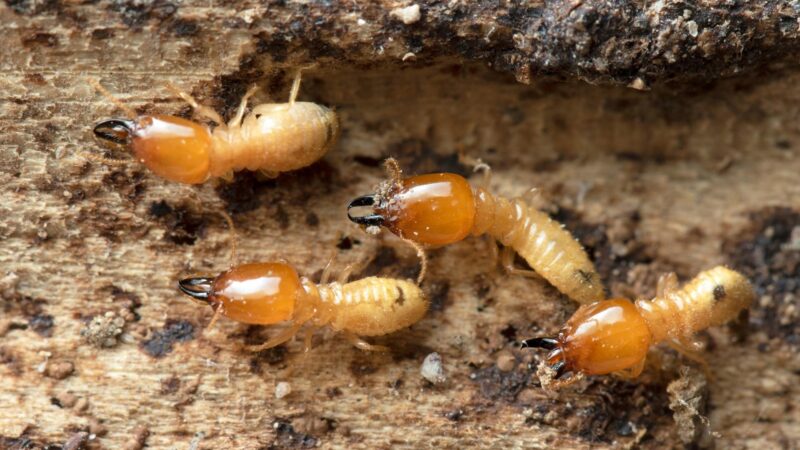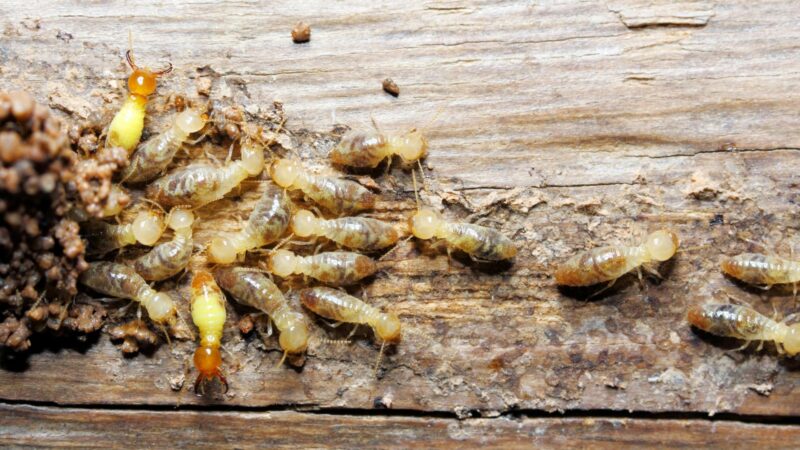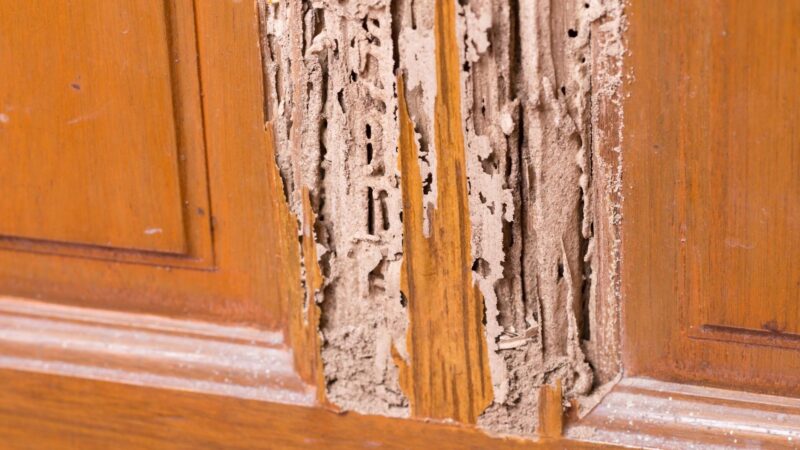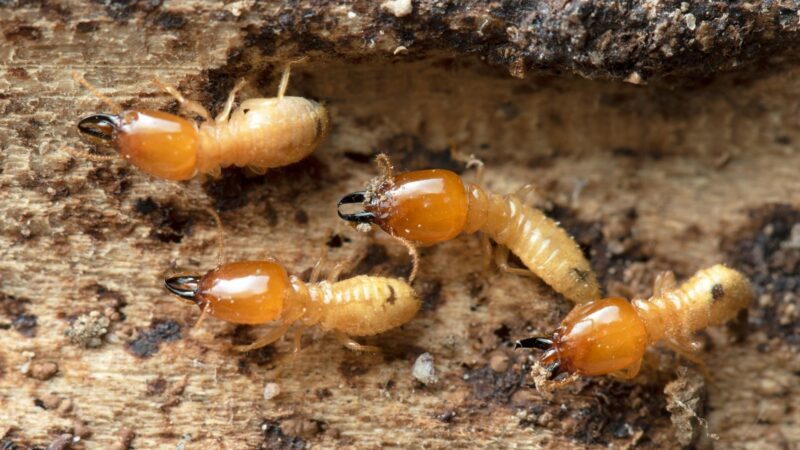Termites are notoriously known for being destroyers of homes and buildings due to their wood-chipping prowess. Repairs done to fix termite damage can reach up to thousands of dollars per homeowner or building contractor.
Wooden floors, walls, and other structures will buckle, sag, blister, or bend when there is significant termite damage. They will also look swollen or with visible, faint lines or mazes. There can also be tiny holes that the termites have chipped their way through, with pieces of soil surrounding each hole.
To know more about termite damage, what it looks like, how to search for damage or the presence of termites in your home, how to repair and prevent termite damage, and other interesting information, just read further this article!
How Bad Is Termite Damage?

Termites can cause billions worth of dollars in damage annually in the country. In fact, the U.S. Structural Pest Control incurred an estimated $10.4 billion in revenues through the provision of pest control services in 2021, which is an 8.2 percent increase from the $9.6 billion estimate in 2020.
Not only do termites feed on wood, but they also destroy insulation, paper, swimming pool filtration, liner systems, plants (live shrubs, trees, and woody plants), and other materials that are made up of cellulose.
Although it is a rare occurrence, termites can also bite humans. It is usually harmless because they have small mandibles and are unable to carry diseases, but open bite wounds can cause infections if left untreated.
Additionally, there is also emotional damage from having to experience seeing thousands of termites emerging when they swarm, especially considering that homes and buildings are a personal investment.
How Do Termites Cause So Much Destruction to Homes?

This is because termite colonies can compose up to 200,000 individuals or more. Additionally, members of the colony are constantly being produced by the queen. On average, a queen termite can lay up to 30,000 eggs a day.
However, it may take several months to years, depending on the size and the rate of maturity of the colony, before termites can significantly cause damage to homes and buildings.
Once a termite colony becomes well-developed, worker termites are tasked to expand both their feeding range and their nest, affecting more wooden areas and materials in the process. A single colony can have a foraging area one-third the size of a football field.
What Does Termite Damage Look Like?

It depends on colony size and how long they have been feeding. Termite damage resembles water damage — wooden structures will sag, bend, buckle, or blister. Wood can buckle, floors and ceilings will look swollen, and there will be visible lines or mazes on infested furniture and walls.
Moreover, as they consume soft springwood, they leave excrements in the shape of pellets or on the inside wood. Other evidence includes mud tubes and detached wings.
However, most termite damage is difficult to detect in its early stages as termites often destroy the internal structure of wooden areas and materials. Therefore, it is usually not visible unless you actively look for signs of damage yourself.
What Does Termite Damage Look Like in Drywall?
Drywalls or plasters will have tiny holes bore onto them with bits and pieces of soil around each hole. Termites can also leave sunken or rippled traces on or behind wall coverings as evidence that they have built tunnels underneath.
Other evidence includes faint and thin lines, peeling or bubbling appearance of paint, mud tubes or fecal droppings located at the base of the wall, and powder-like dust also found at the base or on the floor near the base of the wall.
Again, drywall damage caused by termites is not easily detected as the exterior can remain fully intact.
What Does Termite Damage Look Like on Hardwood Floors?
Infested hardwood floors may sound squeaky when stopped on or will have depressions or places that buckle or sag since termites will typically destroy the joists that hold the floor structures up. When damage is extensive, the wooden boards of the floor can loosen and even pull away completely.
How to Look For Termite Damage?

- Use the handle of a screwdriver or a knife to tap wooden surfaces, areas, and materials. Pay closer attention to wall stud bases, sill plates, flooring, and joists (both floors’ ends joists and header joists). If it sounds hollow, termites may be present in or near your vicinity.
- Damaged wooden materials may have surfaces that are a gray-brown coloration and are gritty in texture.
- Look for mud tubes on wood or foundation walls. Even empty tubes are a cause for concern, as it does not necessarily mean the termites have left. It may be because that specific tube is abandoned and has established a new one somewhere in or around your house.
- Look for holes in wood and fecal pellets that look like fine grains of sand. These are excreted by drywood termites who do not create mud tubes but instead infest directly deep into wooden areas.
- Termites, specifically swarmers or winged adult termites, are often mistaken for flying ants. So, if you see a stray live or dead termite, discern whether it is truly a termite before worrying. It should have straight antennae, a thick waist, and wings that are of equal length.
What Are the Signs of Termite Damage?

- There are swarmers or winged adult termites outside the foundation of homes, buildings, walls, floors, and other wooden surfaces. They can also be located on a stump of wood near the area.
- Mud tubes that trace the walls, floors, plumbing areas, or foam insulation are visible. You can check to see if the termites in the tube are still active by breaking a small section and see if they’re inside or if they repair it in the next few days.
- If you see any spots made out of dried mud on the inside of a wall, wall covering, or ceiling. Scrape the mud and check if there is a hole underneath or a termite emerging. These spots can also be large, odd-shaped mud formations that are dry.
- There are sunken areas on the wallpaper, paint, floor, roof, and other surfaces. This is because termites might have built galleries beneath them.
- Fecal pellets on a countertop or floor can also indicate termite infestation, specifically of drywood termites, as they leave them behind.
Related: 8 Early Signs of Termites in Walls and How to Detect Them | Identification and Control Guide
How to Repair Termite Damaged Wood Floors?
If termites haven’t penetrated through the foundation of your floors, you can still salvage the situation by replacing or repairing loose planks or boards. On floors that have sunken due to termite damage, place wood filler and sand, then refinish.
However, it is important to note that fixing termite damage doesn’t eradicate the termites themselves. In this case, you would have to contact professional pest control services immediately.
How to Prevent Termite Damage?
1. Sanitation
Eradicate any wood debris on the floors of your house or building to remove potential food sources for termites. This includes removing form boards, grade stakes, and other wood scraps from soil outside your home. Make sure you haven’t placed any wood under patios, steps, or porches, as that could easily attract termites.
2. Minimize Moisture
Termites prefer moist soil conditions to survive. Lessen the amount of moisture in the soil by constructing an efficient water drainage system and make sure the finished grade of a foundation wall is sloped away from the drainage to prevent the downpour of water. In buildings that have built-in crawl spaces, there should be ventilation outlets for sufficient air movement.
3. Plant Placement
If you are a gardening enthusiast and you want to plant a thriving set of shrubs or trees, don’t plan them near the foundation of your walls as they may potentially hide termite activity. If they grow big enough, make sure to trim branches or trunks that touch the house to prevent any entry points for termites.
4. Physical Barriers
Barriers, such as steel mesh and sand, are usually incorporated during the construction of the walls, floors, and other surfaces, but they can also be done after termite damage treatment is done.
How to Treat Termite Damage?
Call for a professional. Performing house treatments for termite infestations is not recommended unless you’re an expert in the field yourself.
Not only does it require special skills and knowledge of termite behavior and biology, but termite control also utilizes equipment that is specialized to remove them, such as long metal rods for soil injection, powerful masonry drills, and heavy-capacity spray tanks.
Treatments also include using hundreds of gallons of termiticides that are injected inside foundation walls, into the ground along or near foundations, and beneath concrete slabs.
Should You Buy a House With Repaired Termite Damage?
It depends if the structural damage has been resolved. There can be instances where pest control services failed to completely eradicate termites, they can reemerge in the house or building. In this case, look for another house, or else you would shoulder the burden and costs of fixing and treating the house.
Otherwise, you can continue purchasing the house if termite damage has been thoroughly repaired and there are no signs of termites anywhere. Just make sure to perform an inspection.
How Much Does It Cost to Fix Termite Damage?
Treatment costs for a typical single-family home will range somewhere between $1,000 to $2,000. If the buyer has opted for a termite baiting system, a $200 annual contract renewal fee is also charged to them.
Does Homeowners Insurance Cover Termite Damage?
It depends on the insurance policy a homeowner or building contractor has availed. However, repair costs for termite damage are usually not accounted for in an insurance policy since pest control plans are left to the jurisdiction of pest control companies.
How to Assess Termite Damage?
The most common way to assess termite damage is to examine the physical condition of walls, floors, and any other areas and surfaces that termites can potentially damage. Take note of any new problems that you have encountered while wandering through your house.
Who Pays for Termite Damage When Buying a Home?
The burden of paying for termite damage falls onto the buyers themselves. This also includes any future prevention costs.
Termite damage can cost a considerable amount of money for homeowners and building contractors. Depending on the size of the termite colony and the rate of feeding, termites can significantly destroy wooden structures and foundations. However, it may take several months to years for the damage to be visible enough.
List of Sources
Green, J. Termite Infestations. University of Nebraska–Lincoln.
Houseman, R. M. (2004). Subterranean Termites. University of Missouri.
Termites. (2020). Iowa State University.
Layton, B. Common Questions about Termites and Termite Control. Mississippi State University.
- What Does Termite Damage Look Like? | Information and Facts - October 8, 2022
- Are White Ants and Termites the Same? | All You Need to Know! - October 9, 2021
- How to Get Rid of Subterranean Termites | Effective DIY Techniques - September 8, 2021
